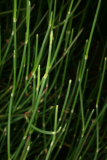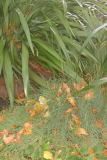Additional notes (click to expand)
Commemorative
The species is named for James Gilbert Gerard (1793–1835), a Scottish army surgeon in the Bengal Medical Service who collected plants in the Himalayas (and not for John Gerard the 16th/17th century surgeon/herbalist). He served in Nepal in 1815 with the Gurkhas in the 1st Nasiri Battalion of the British army in Bengal, and his grave at Subathu notes his death on 31 March 1835 at the age of 42. While in Sabathu he was paid 80 rupees a month for superintending the Vaccine Establishment there (1823–4), but later records show that he travelled on full military pay through Afghanistan and Central Asia (1831–3). The plant is also named for his two brothers, Patrick (1794–1848), a meteorologist, and Alexander (1792–1839), a scientist. On his younger brother’s grave (Captain Patrick Gerard, of the same regiment) in Simla, it notes how the three brothers were among the first to explore the Trans-Himalayan regions. Captain Alexander Gerard was in the 27th Native Infantry and his two-volume Narrative of a journey from Caunpoor to the
Boorendo pass in the Himalaya Mountains viâ Gwalior, Agra, Delhi, and Sirhind (1810, with others), and A map of Koonawar and Account of Koonawar in the Himalaya (published posthumously, 1841) from his travels in 1817 and 1818 (accompanied on this occasion by James) have little of botanical interest. Alexander died of malaria, which recurred while back in Aberdeen. They were responsible for the discovery of Simla, then in deep forest but later an important European residential area. They do seem to have spent years doing nothing else than walking (and no ‘soldiering’) where few, if any, Europeans had ever been before, surveying and recording.
Oakeley, Dr. Henry. (2012). Doctors in the Medicinal Garden. Plants named after physicians. Royal College of Physicians.
link
Horticulture
A dense, thick-forming shrub with upright, jointed, deep green shoots. Bears insignificant, yellowish green flowers in summer. Spherical red fruit, 1cm across, in autumn. 60cm (24in) high by 3m (10ft) wide or more. Pest and disease trouble free.
Brickell, C. (2003). A-Z Encyclopedia of Garden Plants. Dorling Kindersley. p.408
Found on rocky inclines ranging from Afghanistan to China and the Indian subcontinent, this creeping shrub with scale-like leaves is a hardy member of the family Ephedraceae. In the Medicinal Garden it provides an excellent evergreen ground cover for dry soil at the base of a large plane tree. The variety sikkimensis is more vigorous than the type species which also grows happily nearby. It is easily propagated by careful division of plants in spring (by Clare Beacham).
Oakeley, Dr. Henry. (2012). Doctors in the Medicinal Garden. Plants named after physicians. Royal College of Physicians.
link
Medicinal
Prescription only medicine: ephedrine, pseudephedrine, amphetamine, ecstasy
Induction of noradrenaline release. Contains ephedrine and pseudoephedrine. These are bronchial dilators and vasoconstrictors, used for asthma and nasal congestion. Amphetamines and ecstasy are synthesised from them.
Oakeley, Dr. H.F. (2013). Medicines from RCP plants label list 5-2013.docx.
Ephedra gerardiana. Ephedrine.
A tea made from these primitive plants has been used in China for more than 2000 years to aid sweating and to ease breathing in patients with chest infections. It was adopted in America and Europe in 19th and early 20th centuries to dilate the airways in asthma and to shrink the congested lining of the nose in colds by constricting small blood vessels. Ephedrine is still used to constrict blood vessels and control low blood pressure arising in epidural anaesthesia. There have been dangerous effects from the use of related drugs as a weight loss aid and to stimulate the brain. The active principal Ephedrine fires specific triggers on many types of cells by mimicking the actions of the sympathetic nervous system.
William Harvey and plant derived medicines currently used in cardiovascular medicine, Prof Michael de Swiet's Notes 2018
Nomenclature
gerardiana- Named for James Gilbert Gerard (1795-1835), an army surgeon in India, who collected plants in the Himalayas.
Stearn, W.T. (1996). Dictionary of Plant Names for Gardeners. Cassell. p.150
Ephedra- Greek name for the common mare’s tail (Hippuris) which it somewhat resembles. For botanists, it is of great interest, as the genus forms a linking group between conifers and flowering plants.
Stearn, W.T. (1996). Dictionary of Plant Names for Gardeners. Cassell. p.132
Other use
A cyclist taking amphetamines (synthesised from ephedrine, present in the sap of the primitive plant species Ephedra) died in the 1960 games.
DeSwiet, Michael. (2012). Plants and the Olympic Games.
link
On the corner with St Andrews Place is Ephedra gerardiana, a source of
ephedrine and pseudoephedrine – chemicals with adrenaline-like actions – which
were used as bronchodilators in asthma, and as decongestants in over-the-counter
medicines (eg Benylin). This curious plant, which looks like a Mare’s Tail (Equisetum),
is a major cash crop in China where 30,000 tons a year are reportedly harvested
for the pharmaceutical industry. Pseudoephedrine is now mainly synthesised
from dextrose, and – like all medicines – it has its dark side. Methamphetamine,
a powerful and addictive stimulant, can be synthesised from it – and Ecstasy is
produced from amphetamines.
Oakeley, Dr. H.F. (2013). A tour of the Medicinal Garden of the Royal College of Physicians.
Phytochemistry
Contains ephedrine and pseudoephedrine.
Geographical distribution
- Asia-Temperate, China
- Asia-Temperate, Western Asia, Afghanistan
- Asia-Tropical, Indian Subcontinent, India
- Asia-Tropical, Indian Subcontinent, Nepal
Ephedra gerardiana Stapf
Family: EPHEDRACEAEGenus: Ephedra
Species: gerardiana Stapf
Common names: Indian Jointfir; Pakistani Ephedra
Distribution summary: Afghanistan, China, Indian Subcontinent
Habit: Perennial
Hardiness: H6 - Hardy; very cold winter
Habitat: Dry, sunny, rocky mountains
Garden status: Currently grown
Garden location: Plants of the World (D)
Flowering months: April, May
Reason for growing: Commemorative, medicinal, toxic, prescription only medicine
.JPG)


.JPG)
.JPG)
.JPG)